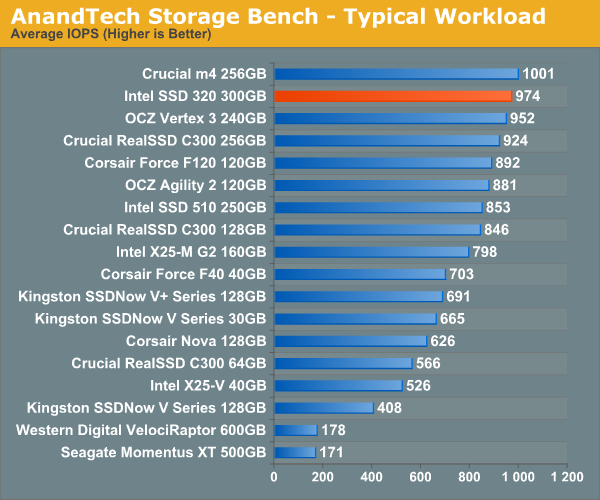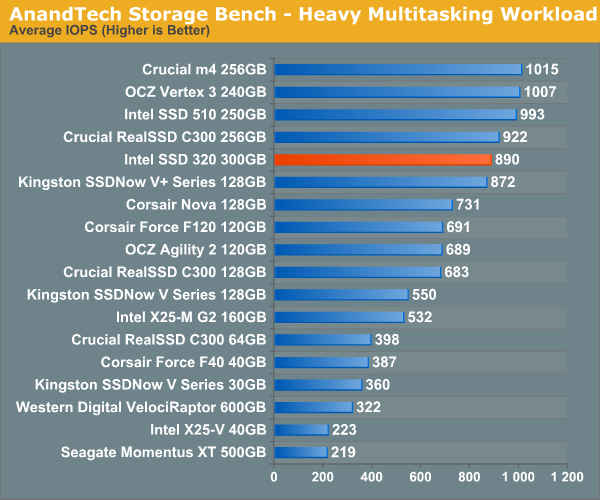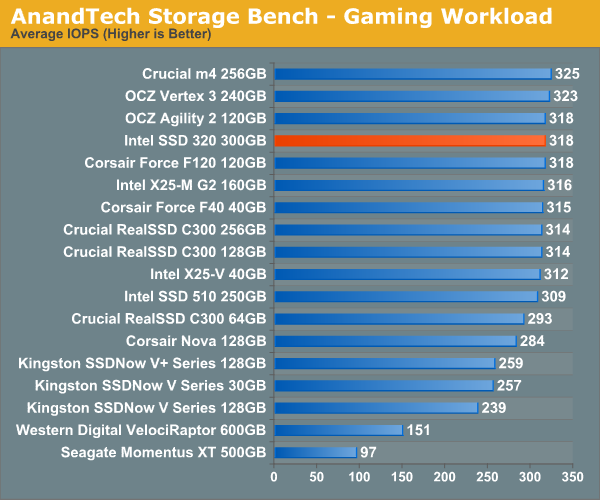The Intel SSD 320 Review: 25nm G3 is Finally Here
by Anand Lal Shimpi on March 28, 2011 11:08 AM EST- Posted in
- IT Computing
- Storage
- SSDs
- Intel
- Intel SSD 320
AnandTech Storage Bench 2010
To keep things consistent we've also included our older Storage Bench. Note that the old storage test system doesn't have a SATA 6Gbps controller, so we only have one result for the 6Gbps drives.
The first in our benchmark suite is a light/typical usage case. The Windows 7 system is loaded with Firefox, Office 2007 and Adobe Reader among other applications. With Firefox we browse web pages like Facebook, AnandTech, Digg and other sites. Outlook is also running and we use it to check emails, create and send a message with a PDF attachment. Adobe Reader is used to view some PDFs. Excel 2007 is used to create a spreadsheet, graphs and save the document. The same goes for Word 2007. We open and step through a presentation in PowerPoint 2007 received as an email attachment before saving it to the desktop. Finally we watch a bit of a Firefly episode in Windows Media Player 11.
There’s some level of multitasking going on here but it’s not unreasonable by any means. Generally the application tasks proceed linearly, with the exception of things like web browsing which may happen in between one of the other tasks.
The recording is played back on all of our drives here today. Remember that we’re isolating disk performance, all we’re doing is playing back every single disk access that happened in that ~5 minute period of usage. The light workload is composed of 37,501 reads and 20,268 writes. Over 30% of the IOs are 4KB, 11% are 16KB, 22% are 32KB and approximately 13% are 64KB in size. Less than 30% of the operations are absolutely sequential in nature. Average queue depth is 6.09 IOs.
The performance results are reported in average I/O Operations per Second (IOPS):

If we strip 6Gbps out of the equation completely, the SSD 320 does very well in our old light workload. You're looking at performance that's at the top of the pack from the mainstream offering.
If there’s a light usage case there’s bound to be a heavy one. In this test we have Microsoft Security Essentials running in the background with real time virus scanning enabled. We also perform a quick scan in the middle of the test. Firefox, Outlook, Excel, Word and Powerpoint are all used the same as they were in the light test. We add Photoshop CS4 to the mix, opening a bunch of 12MP images, editing them, then saving them as highly compressed JPGs for web publishing. Windows 7’s picture viewer is used to view a bunch of pictures on the hard drive. We use 7-zip to create and extract .7z archives. Downloading is also prominently featured in our heavy test; we download large files from the Internet during portions of the benchmark, as well as use uTorrent to grab a couple of torrents. Some of the applications in use are installed during the benchmark, Windows updates are also installed. Towards the end of the test we launch World of Warcraft, play for a few minutes, then delete the folder. This test also takes into account all of the disk accesses that happen while the OS is booting.
The benchmark is 22 minutes long and it consists of 128,895 read operations and 72,411 write operations. Roughly 44% of all IOs were sequential. Approximately 30% of all accesses were 4KB in size, 12% were 16KB in size, 14% were 32KB and 20% were 64KB. Average queue depth was 3.59.

Crank up the workload and the 320 falls a bit behind the rest of the competitors. Last year's heavy multitasking workload is nothing compared to what we introduced earlier this year, so it's still pretty light by comparison but it's clear for normal usage the 320's 3Gbps performance is quite good.
The gaming workload is made up of 75,206 read operations and only 4,592 write operations. Only 20% of the accesses are 4KB in size, nearly 40% are 64KB and 20% are 32KB. A whopping 69% of the IOs are sequential, meaning this is predominantly a sequential read benchmark. The average queue depth is 7.76 IOs.











194 Comments
View All Comments
Cow86 - Monday, March 28, 2011 - link
Awesome, looking forward to it :)adamantinepiggy - Monday, March 28, 2011 - link
Hey Anand, your 256GB Micron/Crucial M4 results on the Vantage HDD test seem to reflect an issue I have had with several P67 motherboards. On the 6G/s ports, on certain MB's, with the Intel SATA driver, it's not running at full speed. The only way I fixed it was to revert the the Intel driver back to the Win7 MSAHCI driver and then update again back to the Intel SATA driver. Why? I have no idea, but that drive should bounce up to the 60,000+ in the Vantage HDD test.I noticed this issue with both a MSI and a ASUS P67 chipset MB. The 45K HHD is the exact same I got here in the Micron R&D lab before I did the MSAHCI swap and the revert back to Intel driver. The MSAHCI driver does about 55K with that drive. then the change back to the Intel driver suddenly bumps the core to 62Kish. This also affects all the other Vantage scores, but is most significantly seen with the HDD test.
Anand Lal Shimpi - Monday, March 28, 2011 - link
Our Vantage scores are actually taken using a Marvell 6Gbps controller, which is why we get much lower numbers in that test than if we used a 6-series board. I'll be switching over entirely pretty soon but for the sake of comparison to older drives (not to mention owners of Marvell 6Gbps SATA controllers) I kept the older testbed as is.Take care,
Anand
nexox - Monday, March 28, 2011 - link
"""the pricing is actually the same or higher than last gen."""Really? The chart in the article says that a 160GB G2 is $404, and a 160GB 320 is $289. Seems like a ~40% decrease to me.
softdrinkviking - Monday, March 28, 2011 - link
i think the implication was that the G2 was 2 generations ago, not last generation.Zhriver - Monday, March 28, 2011 - link
Slightly offtopic.Around the web i see a lot of talk about Intel finally enabling TRIM for raid 0 and 1.
Has Anandtech looked into this yet?
Omid.M - Monday, March 28, 2011 - link
Anand,I read a comment by someone regarding TRIM support in the OS:
TRIM is an excuse for poorly designed controllers.
The statement sounded too conclusive to be taken seriously, as I'm sure the reality is more complicated. The discussion was surrounding which 3rd party SSDs to use with OS X.
Any comments on the validity of the statement?
davepermen - Monday, March 28, 2011 - link
The truth is the reverse: A good controller can negate the need for trim. But trim is still important and should always be there. why, because it's about giving information to an ssd which it can put to good use. Not having that information is just making the life for the drive needlessly difficult.trim is the best way to make an os and an ssd work together in harmony, unimportant the controller. it's the way to allow the ssd what parts of the disk are used by the os and what parts aren't. a good ssd can survive without knowing that. but it's still like forcing someone to work blind, or deaf where he's not actually disabled.
as osx doesn't support trim yet, the argument got reversed (as osx is from apple and thus perfect) => any ssd supporting trim is "cheating". this, of course will change with lion, which will bring trim. then, the argument is an ssd not having trim is stupid, as, again, osx is from apple and thus perfect. /joking.
beepboy - Monday, March 28, 2011 - link
OS X do support TRIM, just gotta do these steps (thanks to xlr8yourmac.com)"Subject: Third-Party TRIM SSD Support in Mac OS X
Hello Mike. I have good news for those people still waiting for support of TRIM command for third-party Solid State Drives (in OS X). Now we have a support!
It was tested with Intel SSD 2nd generation and OCZ Vertex and it is fully working. But for launch to work we need an IOAHCIFamily.kext (Kernel Extension) with Plugin inside called IOAHCIBlockStorage.kext where in the directory you can find a binary with the same name. This can be downloaded now from internet. This kernel extension was taken from Mac OS X 10.6.6 (10J3210) that came with MacBook Pro 2011. (not the std OS X build)
Open it with HEX editor and search for "APPLE SSD". This is verification on "if this Solid State Drive is an Apple or not?" implemented by Apple. Simply change this 9 symbols with first 9 symbols from name of your SSD.
(FYI - per Viktor's later mail (see below), replacing Apple SSD with all Hex zeroes is another/better option)
Install this modified kext with kexthelper (don't forget to rebuild cache with button in kexthelper) and reboot.
Voila!
This is works on latest Mac OS X 10.6.7 and 10.7 Developer Preview.
-Viktor D.
I asked about any proof that trim is really working in OS X, not just the OS reporting it as supported. (Many SSDs have GC support in firmware, which has been a plus for OS X users w/o Trim support.)
Here's his reply regarding proof of trim working.
Ok, there are three things:
1) Apple can do it (just show "yes") through detecting media type of Disk in System Profiler (which is more simple) instead of using for this AHCI driver. And another thing - this is all SSDs, just with different names, which all supports unified commands.
2) IOAHCIBlockStorage.kext is not something simple. This driver (Input Output Advanced Host Controller Interface Block Storage) manages all IO for SATA Storage Devices, ie. NCQ, R/W operations, TRIM, etc.. How OS checks that TRIM is supported and works in drive? As you can see in my last message - we tested a group of disks, the ones which support TRIM natively and those which produced early that lacked TRIM support. Those disk that supported it, OS recognized. Those which lacked it OS shows "TRIM Support: No" without exception. To check - IOAHCI after detecting that this is not "rotational" disk (reports no spinning speed), it sends the TRIM commands "BuildATATrimCommand" (found inside IOAHCIBlockStoorage) to the SSD. If SSD executes this, on specific address of clusters after trimming will be zeroes like if we had a secure format with zeroes, then IOAHCI reports that command executed, and SSD supports TRIMming. If the command was ignored and not executed, OS reports that this SSD doesn't support TRIM. This command is not a process which can be monitored by Activity Monitor. It is just a command to SSD's controller which will do this work fully automatically without OS intrusion. This is the algorithm to understand "how os checks that TRIM is supported and executed".
3) Another proof. First what we noted is reverting performance via synthetic test back to original. Another - is using "hdparm" method. Booted in linux, mount SSD with HFS, creates small file in specific place and saves the info about address of sectors that contains that file. In linux TRIM is turned off for HFS. Boot to OS X and delete this file. Back to linux - check the address - and we see only zeros. TRIM is working.
(In theory any SSD that supports TRIM should work but he later wrote with results of more testing)
Some more information about activated TRIM tests with other SSDs. These models tested and TRIM verified working:
Kingston V+ SSDNow Series
Intel X25-S/M 2nd Gen Series
Western Digital Silicon Edge Blue Series
OCZ Agility 2 Series
OCZ Vertex Series
-Viktor D."
B3an - Monday, March 28, 2011 - link
All that just to get TRIM working in OSX?"It just works" .. yeah right, Apple.